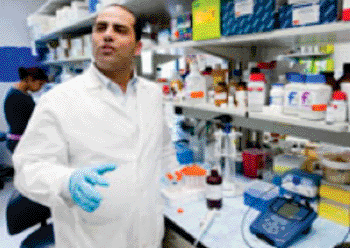Nilotinib Enhances Toxic Protein Removal from Parkinson's Disease Neurons
By LabMedica International staff writers
Posted on 21 May 2013
The anticancer drug nilotinib induces clearance of the toxic protein alpha-synuclein from neurons in a mouse model of Parkinson's disease and ameliorates symptoms of the disease.Posted on 21 May 2013
Parkinson's disease is a movement disorder characterized by death of dopaminergic substantia nigra (SN) neurons and brain accumulation of the protein alpha-synuclein.

Image: Senior author Dr. Charbel E-H Moussa (Photo courtesy of Georgetown University Medical Center).
Investigators at Georgetown University Medical Center (Washington DC, USA) worked with a mouse model of Parkinson’s disease. They reported in the May 10, 2013, online edition of the journal Human Molecular Genetics that lentiviral transfection of the gene encoding alpha-synuclein into the mouse SN lead to activation (phosphorylation) of the tyrosine kinase Abl and that lentiviral transfection of the gene encoding Abl increased alpha-synuclein levels, which exacerbated the disease. Administration of the tyrosine-kinase inhibitor nilotinib decreased Abl activity and increased autophagic clearance of alpha-synuclein into lysosomes in transgenic and lentiviral gene-transfer models.
The drug nilotinib was approved as Tasigna in the USA and the EU for drug-resistant chronic myelogenous leukemia (CML). In 2006, a Phase I clinical trial found that nilotinib had a relatively favorable safety profile and showed activity in cases of CML resistant to treatment with imatinib (Gleevec [USA]/ Glivec [Europe, Australia, and Latin America]), another tyrosine kinase inhibitor currently used as a first-line treatment. In that study, 92% of patients (already resistant or unresponsive to imatinib) achieved a normal white blood cell counts after five months of treatment.
In the current study, nilotinib, which enters the brain within [US] Food and Drug Administration approved doses, led to autophagic degradation of alpha-synuclein, protection of SN neurons and improvement of motor performance in the Parkinson's disease mice.
"No one has tried anything like this before," said senior author Dr. Charbel E-H Moussa, assistant professor of neuroscience at the Georgetown University Medical Center. "This drug, in very low doses, turns on the garbage disposal machinery inside neurons to clear toxic proteins from the cell. By clearing intracellular proteins, the drug prevents their accumulation in pathological inclusions called Lewy bodies and/or tangles, and also prevents amyloid secretion into the extracellular space between neurons, so proteins do not form toxic clumps or plaques in the brain."
"The doses used to treat CML are high enough that the drug pushes cells to chew up their own internal organelles, causing self-cannibalization and cell death," said Dr. Moussa. "We reasoned that small doses—for these mice, an equivalent to 1% of the dose used in humans—would turn on just enough autophagy in neurons that the cells would clear malfunctioning proteins, and nothing else. We successfully tested this for several diseases models that have an accumulation of intracellular protein. It gets rid of alpha-synuclein and tau in a number of movement disorders, such as Parkinson's disease as well as Lewy body dementia."
Related Links:
Georgetown University Medical Center














